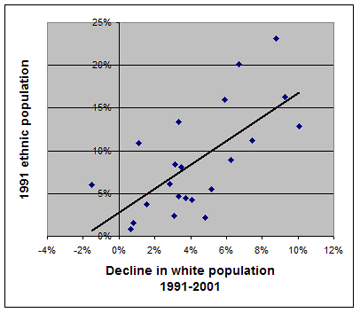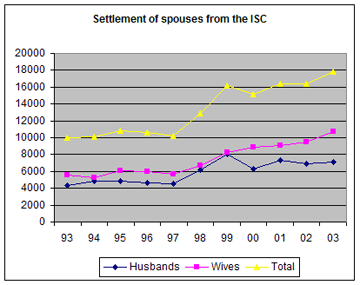The impact of chain migration on English cities
5 April, 2005
Summary1. Government proposals on chain migration have overlooked the most important factor - transcontinental arranged marriages.
2. A comparison of the censuses of 1991 and 2001 shows a clear pattern of decline in the white population of the more highly ethnic local authorities in the metropolitan areas of Greater Manchester, West Midlands and West Yorkshire. The cities of Manchester, Birmingham and Bradford respectively have shown the largest overall decline in white population in each of these areas.
3. This has been accompanied by a rapid increase in the Pakistani population in these three cities by between 45.8% and 52.8%. The smaller Bangladeshi population has also seen large increases.
4. A major factor is the high rate of marriage to partners on the Indian Sub Continent which we estimate at 50-70%. This substantially increases the rate of household formation and, certainly in the first generation, the size of families.
5. It also partly explains the conclusion of the Government's Cohesion panel that "The 'pace of change' (for a variety of reasons) is simply too great at present".
Detail
6. The government's five year strategy for asylum and immigration [1] refers to "ending chain migration". Their proposal to impose a delay of five years before those who have settled on a family reunion basis can themselves sponsor further family members is welcome and overdue. However, they have neglected the most important source of chain migration - transcontinental arranged marriages - which is having a major impact on a number of English cities.
7. A comparison of the 1991 and 2001 censuses [2] shows that there is clear evidence of a link between the proportion of ethnic minorities in a particular area and the rate at which the white population has declined. The following chart shows the decline in the white population (a negative value indicates an increase in population) against the 1991 ethnic minority percentage of the total population for the local authorities in the three Metropolitan areas of Greater Manchester, West Midlands and West Yorkshire.

8. The areas showing the greatest absolute decline in their white populations in each Metropolitan area were Manchester (36,227 from a 1991 white population of 359,000), Birmingham (67,161 from a 1991 white population of 766,000 ) and Bradford (23,105 from a 1991 white population of 392,000). In the last 4 years for which data is available, 1999-2003, there has been a steady internal migration of people from these cities to the rest of the UK. This totalled 12,200, 36,700 and 11,100 people for Manchester, Birmingham and Bradford respectively over this 4 year period. This flow is not likely to be entirely made up of the white population but it does point to a continuing decline of the white population in these cities.
9. These three cities have also seen large increases in their ethnic minority populations. In fact, the increases in the total ethnic minority populations and the reduction in the white populations for Birmingham and Bradford are similar in scale as the following table shows:
Reduction in white population |
Increase in ethnic minority population |
Increase / |
|
| Manchester | 36,227 |
16,168 |
-20,059 |
| Birmingham | 67,161 |
62,440 |
-4,721 |
| Bradford | 23,105 |
24,160 |
+1,055 |
| 1991 populations have been increased to reflect the difference between the 1991 census and the 1991 mid-year population estimates. The increases used reflect the ratios of the ethnic population for England based on the mid-year estimate to the England ethnic populations recorded in the census. |
| The 2001 census contained mixed ethnic categories which were not present in the 1991 census. To enable a comparison to be made with the 1991 census people who categorised themselves as Mixed White and Black Caribbean and mixed White and Black African were added half to the 2001 white population and half to the 2001 black population. Similarly half of those who classified themselves as mixed White and Asian were added to the White population and the other half of this group were apportioned between the Indian, Pakistani, Bangladeshi and Other Asian populations in relation to the base population of those countries. |
The following graphs show the overall change and the percentage change in the ethnic composition of the population.
Click here to see the graphs.
10. The percentage changes for the Chinese and Other Asian ethnic groups, although large, are from a very small base (less than 6,000 population in 1991 for both ethnic groups in all 3 cities) and would be heavily impacted by relatively modest levels of immigration. . The growth of the Indian and Black communities which has started from a higher base, has been moderate reflecting the settled nature of these communities and the fall in their total fertility rates towards UK norms [3].
11. The biggest change in overall numbers is amongst Pakistanis - adding to populations which were already significant in 1991 at 4%, 7% and 10% of the population of Manchester, Birmingham and Bradford respectively. In Manchester their numbers increased from 16,101 in 1991 to 23,883 in 2001 - a 48% increase. In Birmingham the corresponding numbers were 69,223 in 1991 rising to 105,819 in 2001 (a 53% increase) and in Bradford 47,430 in 1991 rising to 69,121 in 2001 (a 46% increase). There are a number of reasons for these large increases. The age profile of the Pakistani population would have been younger than the average for the population as a whole and hence the number of women of child-bearing age would have been proportionately larger. But, in addition, there has been continued migration from Pakistan and the fertility rates of women born in Pakistan are high. In 1991 for the UK-born population as a whole it was 1.8 in comparison with 4.8 for Pakistan- born mothers. In 2001 the corresponding rates were 1.6 and 4.7 [4].
12. The Bangladeshi population of Birmingham (we selected Birmingham because the 1991 Bangladeshi population of Manchester and Bradford was small (2,087 and 3,818 respectively making analysis of change difficult - see paragraph 10 above) which stood at 13,300 in 1991 increased by 59% by 2001 to over 21,000 in 2001. The reasons for the large increase are similar to those for the Pakistanis - an existing young population which is supplemented by a high proportion of marriages to partners from Bangladesh and a high fertility rate for Bangladesh-born women (total fertility rate 5.3 and 3.9 in 1991 and 2001 respectively) [5].
13. As late as 2001, it was estimated that 60% of Pakistani and Bangladeshi marriages in Bradford were with a spouse from the country of origin [6]. The percentages in Manchester and Birmingham are likely to be similar. This therefore increases the rate of household formation and the size of families and thus creates a very rapid change in the composition of the population of the areas in which they live.
14. This may explain why, in 2002, the Home Secretary called for 'a discussion to be had within these communities [from the Indian Sub-Continent] that continue the practice of arranged marriages as to whether more of these could be undertaken within the settled community here' [7].
15. In practice the number of spouses from the Indian Sub-Continent (ISC) granted settlement in the UK has continued to rise, as shown in the following graph.

16. In recent years some of the spouses being granted settlement in the UK may have been spouses of work permit holders and refugees. However, the number of people given refugee status or granted exceptional leave to remain in the UK from these countries is relatively small (just 390 in 2003). The number of people from Bangladesh and Pakistan granted settlement on the basis of work is also quite small. This suggests that the vast majority of settlement of spouses for these two countries, at least, results from marriage. Even assuming that each work permit holder and each refugee brings in a spouse it would mean that, in 2003, 3,435 spouses from Bangladesh and 8,160 spouses from Pakistan were granted settlement in the UK as a result of marriage. The average number of Bangladeshis and Pakistanis in each year of the 15-24 year age group at the 2001 census were 6,406 and 15,806 [8] respectively. This suggests marriage rates of at least 54% and 52% (and probably significantly higher than this) to partners from Bangladesh and Pakistan respectively.[9]
17. The corresponding data and calculations for the Indian population would indicate that 3,925 spouses were granted settlement in the UK in 2003 as a result of marriage to a UK citizen if it is assumed that each work permit holder and refugee was accompanied by or brought in a spouse. The average number of Indians in the 15-24 age group at the 2001 census was 18,412. This suggest marriage rates of at least 21% - and probably nearer to 35% [10] - significant but much lower than the Bangladeshi and Pakistani populations. The total fertility rate of women born in India is also very much lower at 2.3 [11].
18. The combination of the movement of the white population from the inner cities and the impact of immigration through marriages to partners from the Indian cub continent is rapidly changing the ethnic mix of the cities of Manchester, Birmingham and Bradford.
19. The significance of this was summed up by the Government's Community Cohesion Panel reporting in July 2004: "Further, there are other concerns about the speed at which newcomers can be accommodated. Housing, education, health and other services all take time to expand. But people also take time to adjust. The identity of the host community will be challenged and they need sufficient time to come to terms with and accommodate incoming groups, regardless of their ethnic origin. The 'pace of change' (for a variety of reasons) is simply too great in some areas at present." [12]
Footnotes
| [1] | Controlling our borders: Making migration work for Britain, paragraph 39 |
| [2] | Due to changes in the ethnic classification between the 1991 and 2001 census it is not possible to directly compare data from the two censuses. The following adjustments have therefore been made to the base data: |
| [3] | Births are not analysed by ethnic group by the ONS but, according to an article published in Population Trends No 104 by the ONS by Richard Berthoud of the Institute for Social and Economic Research at the University of Essex, ‘…. Pakistani and Bangladeshi ….. have, on average, far more children than is the norm among white, Indian or black women.’ |
| [4] | ONS Birth Statistics – Series FM32 – table 9.5 |
| [5] | ibid |
| [6] | Appendix 7 of Lord Ouseley’s report on disturbances in Bradford ‘Race Relations in Bradford’ by GV Mahony |
| [7] | White Paper, “Secure Borders, Safe Haven”. Home Office Feb 2002 |
| [8] | Population for Great Britain from census 2001 – figures for Scotland listed as Pakistani/Other South Asian – assumed to be two-thirds Pakistani and one-third Bangladeshi. |
| [9] | The actual figure is likely to be significantly higher than this as the numbers of Bangladeshis and Pakistanis included in the 2001 census statistics will also include significant numbers of spouses who have already settled in the country. Correcting for this brings the total of marriages contracted with spouses from the ISC nearer to 70%. |
| [10] | As above – Also the number of Indians settling in the UK after working here for 4 years is relatively large. The assumption that all bring in a spouse results in a conservative estimate for the numbers entering through marriage to a British spouse. |
| [11] | As footnote 4. |
| [12] | Community Cohesion Panel July 2004 |
